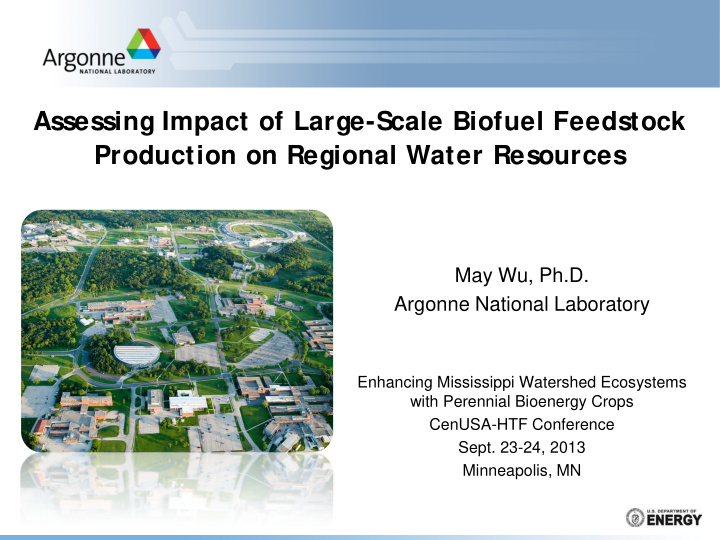



Assessing Impact of Large-Scale Biofuel Feedstock Production on Regional Water Resources May Wu, Ph.D. Argonne National Laboratory Enhancing Mississippi Watershed Ecosystems with Perennial Bioenergy Crops CenUSA-HTF Conference Sept. 23-24, 2013 Minneapolis, MN
Great Mississippi River Basin: Multiple Outputs and Burdens 40 EISA Major hub for current biofuel production, 95% 30 Billion gallons per year conventional biofuel 20 High potential for cellulosic biofuel (agricultural 10 residue, perennial, etc.) Historical water quality issues associated with 0 nitrogen and phosphorus 2
Potential Cellulosic Biomass Resources for Biofuel Production ● Billion-Ton Resource Update (DOE) − Cellulosic biomass feedstock of nearly 1.1 billion dry tons potentially available for biofuel production by 2030 − Replace approximately 30% of the nation’s current petroleum consumption ● Perennial grass ─ Non-food energy crop Miscanthus ─ Used in conservation program ─ Impact of biofuel production from perennial on water resource has Switchgrass not been fully evaluated Local resource constraint • • Competing water use (Power, domestic use, other industries) • Climate change Source: US DOE 2011, 2006 3
Analytical Framework for Water Analysis • Addresses water quality in tributary basins of Mississippi river basin by developing watershed models. • Advance understanding • Considers water consumption across of regional climates, biofuel production supply chain with a land usage, water focus on feedstock production and issues, and soil types as refinery they relate to feedstock • production Characterize spatial-explicit water • footprint of biofuels produced from Support development of conventional crops, agricultural residue, diverse, non-food perennials, and forest resources, algae feedstock that improve biofuel. ecosystem services 4
Examine Options to Meet Sustainability Requirement for the Biofuel Production System Using SWAT Watershed Identify sub basins that have shown environmental loading: strong response to a change in land N, P, SS use for biofuel feedstock production Assist in a variety of management decisions and protection strategies to meet regulatory limit and sustainability criteria Factors considered Surface water Ground water Biofuel feedstock: grain, residue, perennial, energy crop Land use changes Agricultural management and practices Yield increase 5
Perennial Energy Crop is Effective in Reducing Soil Loss and Capture Some of the Run-off Phosphorus 2.0% Upper Mississippi River Basin Relative changes to the baseline 0.0% Scenario: -2.0% Harvest 8 million dry short ton of perennial biomass -4.0% producing 690 million gallons -6.0% of biofuel High yield High yield High yield SWG SWG -8.0% Stover Stover low high Sediment loading decrease: 14% 24% yield yield -10.0% >2% SI SII-2 SII-4 SIII SWG SIII-2 Phosphorus loading decrease: SWG Total P loading Total Flow Total sediment loading 1-2% Flow decrease: 2% BT2 projected significant land Plant transpiration may conversion from crop to idle, from idle increase in the region when to pasture, and from pasture to pasture land converted to perennial bioenergy crops. grow perennial grass Riparian/CRP land can grow perennials. Source: Wu, et al. 2012, Biomass Bioeng.
Modeling Future Production and Climate Impacts Change of Nitrate Loadings • Increased production Increased production from 2006-2022 • Increased production with UMRB ORB climate change • Results mixed ─ Evapotranspiration Runoff ─ N, P Sediment Increased production with response to climate change • Identify potential hot spot and assist evaluating UMRB mitigation program that could reduce negative impact Sources: 1. Demissie et al. 2012, ES&T 7 2. Manuscript under preparation
Biofuel Water Footprint Accounting Biofuel life cycle Blue water footprint – Surface and ground water use by crops and biorefinery Green water footprint – Rainfall use by crops Grey water footprint – Volume-equivalent water required to dilute chemicals to acceptable level 8
Water Footprint of Biofuel Produced from Switchgrass and Miscanthus Green Water Footprint Distribution of Perennial Production - BT2 scenario BT2 scenario, 76.9 Million d.s.t. Estimated switchgrass ET (mm/yr) Distribution of Various Types: Nitrogen Grey Water Satellite imagery grass ET (mm/yr) Miscanthus and Lowland SWG Footprint: dominant Relatively small 9 Manuscript under preparation
Develop Water Sustainable Biofuel Production through Multiple Resource Planning Water-biofuel nexus must be examined on regional basis to account for land availability, water resource, soil, and climate factors. Development of a region-specific biofuel feedstock mix (starch, SWG and MXG biofuel cellulosic, sugar, and oil crops) is essential for a water-sustainable biofuel production. Using perennial grass as feedstock can assist soil runoff control and Source: Chiu and Wu, ES&T 2012; BioFPR 2013. reduce nutrient loss to water body while producing additional biofuels. Biorefinery site selection should incorporate local water resource constraints, in addition to economic and infrastructure considerations. 10
Acknowledgement Argonne National Laboratory Sponsors Y. Chiu, Y. Demissie, S. Yalamanchili, Department of Energy EERE Office E. Yan Bioenergy Technology Office US Army Corp. Engineers Z. Zhang Contact: mwu@anl.gov 11
Recommend
More recommend